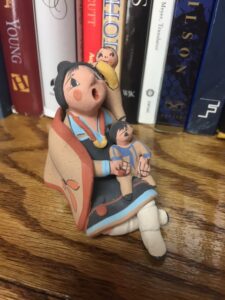 John 20:1-18
John 20:1-18
Many years ago, my parents moved into a nice rental house in a nice neighborhood. This was shortly after I graduated high school. Most of the years I was growing up, we had lived in town houses, in neighborhoods where they were all rentals. They were okay; there was nothing wrong with them. But this place was different; it was pretty nice. I don’t know how they found this place, probably from an ad the owner had put in the newspaper. And we didn’t know why he was renting out the house, he just was.
But nothing abhors a vacuum like the imagination. My mother was great at developing stories. My mother’s favorite words were, “I wonder…” as she began to let her imagination spin out a tale that would give meaning to whatever was on her mind. When she began wondering about our landlord, she went to work.
She asked aloud, “I wonder why he and his wife don’t want to live in this house.” There must be a reason. Perhaps this woman is his second wife. Perhaps he lived here years ago with his first wife. This was the house they bought together. But then they got a divorce – it was very sad.
He probably lived in this house after the divorce – she moved away, out of the area. It was for the best. Then he met another woman and married again. But she couldn’t, wouldn’t live in this house, the house of his first wife. Even though it’s a really nice house, there were just too many memories here. Of course, they couldn’t live here. It was she, the new wife, who insisted that they find a new house that would be their home.
And after she told us this story, it was a drop-the-mic moment. Boom. Her work was done. Now we had a good story to fill in the gaps. And it was such a good story; how could it not be true?
I will tell you the truth, I did some embellishing of my own on this story about my mother, although the essence of it is certainly true. And I don’t think my mother would mind at all, because she was all for making a good story even better.
But, I’m thinking, this might be why women have been thought to be untrustworthy witnesses.
Historically, we know, the words of women have not been taken seriously. This is true. In ancient Jewish history, an authoritative list of ten categories of people who are not competent to testify, women are at the top of the list. Women were not believed to be reliable witnesses – And it wasn’t just a Jewish thing – it was a human thing.
Throughout most of human history, women’s stories have been laughed at, scoffed at, and brushed off. Sometimes for unfair reasons – the idea that women are too emotional, or too easily confused. But it occurs to me, it might also be because women are good storytellers. Stories are, in fact, important to women. It is through stories that women tell their truth.
Very often, it is not enough to just state a fact. Many truths need to be told as stories, so we can hear it and see it and feel it. With a story, it’s like you are there, you know this truth intimately. Joe Friday might want “Just the facts, ma’am” but women have stories to tell. And the women had quite a story to tell about that Sunday morning outside Jerusalem. So sit back and let me tell you the story.
Jesus was gone – his body was gone from the tomb. It wasn’t something that anybody had been expecting. Just the Friday before, his body had been taken down from the cross. It was about mid-afternoon. Joseph of Arimathea, along with Nicodemus, collected his body. Nicodemus, you might remember, is the one who had once paid a late-night visit to Jesus because he wanted so much to understand but couldn’t understand, at least not then. These two men carried his body out to a tomb where they would lay it, along with the myrrh and aloe for the embalming. Some say Nicodemus carried more than 100 pounds of myrrh and aloe. Most people would say that you don’t really need that much, 40 pounds will do the job. But 100 pounds of myrrh and aloe – I think that tells us something about where Nicodemus’s heart and mind were now. And that’s another story to tell.
And so they carried the body and the herbs and spices and clothes to the garden where the tomb was. It was Joseph’s tomb, actually. He assumed he would be buried there some day, but on this day, he could think of no better use of it than to lay the body of Jesus in it. By the time they arrived at the tomb, it was near sunset.
The Sabbath was coming. Even with all the events that had transpired this day, it would not be acceptable to violate the Sabbath laws. They could not be handling a dead body on this holy day, and they needed to be getting home on time for the evening prayers. So Nicodemus and Joseph left Jesus’ body in the tomb, covered the entrance to the tomb with a stone, and they left. There was nothing more that could be, or needed to be, done that day.
Sunday, after the Sabbath, Mary rose very early so she could go to the tomb. She was awake well before sunrise, in fact, so urgently did she feel the need to go and finish the work that had been started on Friday. There were some other women there in Jerusalem too, women who had, along with Mary, accompanied Jesus throughout his ministry. A lot of people think it was just that band of 12 men who followed Jesus, but there were women too – women who used their own resources to provide for him and the disciples. These women had been there at the very beginning, and they were there at the bitter end, and that’s another story to tell.
Some say that it was a few of them who went to the garden that morning – the other Mary and perhaps Joanna. But, it might have been Mary Magdalene, all alone, who made the trip that morning.
When she arrived, she was shocked to find the tomb a dark, gaping hole. The stone had been removed, the grave was open, and the body was gone.
What this could mean, Mary didn’t know. She only knew that the body of her Lord was gone, and that she did not know where he had been taken and she was frantic. More than anything else, she wanted to know where they had taken him so she could go find him. Mary was not ready to let go of Jesus yet.
And she ran back to the house where they had all been staying, and she burst through the door where the men were all gathered, and she said, “They have taken the Lord out of the tomb, and we do not know where they have laid him.” Now, some say that they didn’t believe her, that the men just dismissed it as “idle tales.” You know, the kind of stories women tell. And perhaps some of them did. But not all of them. Not all.
Peter and one of the other men followed Mary back to the garden. And they saw what Mary had seen – an empty tomb. They left, but Mary remained. She still didn’t know what happened to him. She looked into the tomb and saw two angels – they had to be angels. Not everyone agrees about exactly what angels look like, but when you see one, you know. She said to them, “They have taken away my Lord, and I do not know where they have laid him.”
Where is he? Mary wanted to know. She asked the angels, where is he? Because Mary was not ready to let go of him yet. Mary would not go.
And because Mary remained, she was the first to see Jesus in the garden, in the flesh. Mary was the first evangelist, the first bearer of the good news, the apostle to the apostles.
She immediately reached out to touch him, because Mary was not ready to let go of him yet. But he said to her, Mary, don’t hold on to me. She had to let him go.
She had to let him go so that that he could see and be seen by other people in other places and spread the good news widely. She had to let him go so that he could ascend to the father – his father and her father in heaven. She had to let him go so that she, and every one of us, could have him, hold him in our hearts, know him as our redeemer.
Eventually Mary went back to the disciples, her face shining brightly, and told them, “I have seen the Lord.” She told them everything she had seen and heard.
Yes, the men did confirm what this woman had seen and heard, with their own experiences of Jesus later, and these stories, too, will be told. But let us not discount the fact that this woman had been the first to bear witness to the resurrection. Perhaps it was necessary that it be this way. Because women are storytellers, and this is a story that had to be told.
This is a story that is not over yet.
The story of the gospel is a beginning, which shows us the way to follow, the way to live. It is a story that we pick up and carry with us, and we continue writing it with our lives. Each of us has a story to tell – a story that is a piece of the big story. Patch them all together and we have color and depth and texture. And when we share it, it brings new life to others.
And God still speaks through this story that is now our story as well.
This is the story that matters more than any other narrative – the strangest story of all, as C.S. Lewis said. It is a story that tells us, in the end, peace reigns. In the end, life flourishes. In the end, love wins.
It’s a good story. Love wins.
